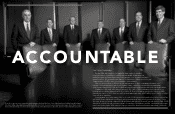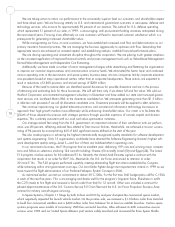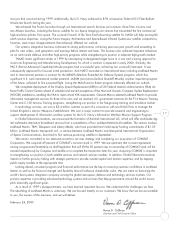Lockheed Martin 1999 Annual Report Download - page 17
Download and view the complete annual report
Please find page 17 of the 1999 Lockheed Martin annual report below. You can navigate through the pages in the report by either clicking on the pages listed below, or by using the keyword search tool below to find specific information within the annual report.
24
MANAGEMENT’S DISCUSSION AND ANALYSIS OF FINANCIAL CONDITION
AND RESULTS OF OPERATIONS
(Continued)
December 31, 1999
The industry participants have reacted to shrinking
defense budgets by combining to maintain critical mass
and attempting to achieve significant cost savings. The U.S.
Government had been supportive of industry consolidation
activities through 1997, and the Corporation had been at
the forefront of these activities. Through its own consolida-
tion activities, the Corporation has been able to pass along
savings to its customers, principally the U.S. Department of
Defense (DOD). With the more recent decline of significant
domestic industry consolidation, major aerospace companies
continue to focus on cost savings and efficiency improve-
ments, as well as generation of cash to repay debt incurred
during this period of consolidation.
Ongoing consolidation continues within the European
aerospace industry resulting in fewer but larger and more
capable competitors, potentially resulting in an environment
where there could be less demand for products from U.S.
companies. Such an environment could affect opportunities
for European partnerships and sales potential for U.S. prod-
ucts outside the U.S.
There are signs that the continuing decline in the
defense budget may have ended, with proposals being
made for modest increases in the next several years. The
Corporation’s broad mix of programs and capabilities
makes it a likely beneficiary of any increased defense
spending. However, there are risks associated with certain
of the programs for which the Corporation is competing
which will be the primary recipients of significant future
U.S. Government spending. These programs are very large
and likely to be well-funded, but may only involve one
prime contractor. For example, the Corporation is involved
in the competition for the Joint Strike Fighter (JSF) tactical
aircraft program. Because of the magnitude of this pro-
gram, being unsuccessful in the competition would be sig-
nificant to any of the competitors’ future fighter aircraft
operations. Additionally, the JSF program and other large,
highly visible programs, such as the Corporation’s F-22
tactical fighter program, frequently receive substantial
Congressional focus as potential targets for reductions
and/or extensions of their funding to pay for other pro-
grams. However, the JSF and F-22 programs remain a
high priority for the DOD and the armed services, as
well as for the Corporation.
As a government contractor, the Corporation is subject
to U.S. Government oversight. The government may investi-
gate and make inquiries of the Corporation’s business
practices and conduct audits of contract performance
and cost accounting. Depending on the results of these
investigations, the government may make claims against
the Corporation. Under U.S. Government procurement regu-
lations and practices, an indictment of a government con-
tractor could result in that contractor being fined and/or
suspended for a period of time from eligibility for bidding
on, or for award of, new government contracts. A convic-
tion could result in debarment for a specified period of
time. Similar government oversight exists in most other
countries where the Corporation conducts business.
Although the outcome of such investigations and inquiries
cannot be predicted, in the opinion of management, there
are no claims, audits or investigations pending against the
Corporation that are likely to have a material adverse effect
on the Corporation’s business or its consolidated results of
operations, cash flows or financial position.
The Corporation remains exposed to other inherent
risks associated with U.S. Government contracting, includ-
ing technological uncertainties and obsolescence, changes
in government policies and dependence on annual Con-
gressional appropriation and allotment of funds. Many
of the Corporation’s programs involve development and
application of state-of-the-art technology aimed at achiev-
ing challenging goals. As a result, setbacks and failures
can occur. It is important for the Corporation to resolve
performance issues related to such programs in a timely
manner to achieve success on these programs.
The Corporation also conducts business in related com-
mercial and non-defense markets. Although these lines of
business are not dependent on defense budgets, they share
many of the risks associated with the Corporation’s defense
businesses, as well as other risks unique to the commercial
marketplace. Such risks include development of competing
products, technological feasibility and product obsolescence.
Industry-wide, the launch vehicle industry experienced
a reduction in demand in 1999 primarily reflecting
start-up issues for certain satellite systems with which the
Corporation was not involved, delays in completing certain
























